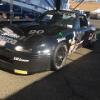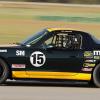
New to alignments help with ride height
#21

 Posted 06-01-2020 02:11 PM
Posted 06-01-2020 02:11 PM

Great stuff Rich!
Level: I found that with a little careful hunting I could find a section of door sill on each side to use a digital level for rake, and find spots on the package shelf and other places for L/R level and then get consistent snd repeatable results. For a given car that can then be translated to shock/spring settings. That was always part of our 1st setup on a car or a rework from scratch.


#22

 Posted 06-01-2020 03:45 PM
Posted 06-01-2020 03:45 PM

#23

 Posted 06-02-2020 09:01 AM
Posted 06-02-2020 09:01 AM

Rich,
Awesome. This was very helpful and hopefully others can utilize this info. We did something very similar to help get close. I had my teammate get the same measurements that you did from his 1.6 SM that has penskes on it. In measuring bumpstop clearance I made a measuring device that is T shaped and I can slip into the space.
How are you setting up your car Rich? Are you making the car level by setting the same bumpstop clearance all the way around?
Kyle
No, I am setting up the car first to a 50% cross weight and then setting in some rake/derake along with some wedge/dewedge depending on individual tracks based on known history as well as just guessing for tracks we have no experience with. Once we get to the track it is then just a matter of letting the car response dictate where we go from there. We also have a highly instrumented car with 12 channels of tire temperature data and shock position sensors that let us know exactly where we are operating making it easy to see if we are in respect to ride heights.
- Kyle Freiheit likes this
#24

 Posted 06-02-2020 10:13 AM
Posted 06-02-2020 10:13 AM

Would the measurement you describe vary from side to side depending on weight distribution. Such as the left front having more threads showing than the right front and essentialy having the same ride height? Or have I misunderstood your method ?
Blake
Blake,
The measurements definitly vary for each position and do so based on each corner's weight load. I would never expect to find individual measured adjuster settings to match side to side. I don't know that I have ever seen that happen.
The good setup needs to starts with proper ballasting the car with driver's weight, a known fuel load and all tire pressures set to a representative "off track" pressure (Don't forget to disconnct the sway bars). I also find it very important to have good "slip" plates or other methods to get consistent results. For a new car setup, I would start by having all four shocks set to the minimum recommendation and then adjust the car to get 50%. This would mean working two adjusters on the axis that is below 50% in small equal steps thereby raising that cross followed by observing how the cross changes, seeing if you can raise one of the adjusters on the opposite cross bringing in a 3rd adjuster to help drive the weight closer to the 50% target. In the end you are trying have 50% cross without being below the recomended minimums. That would then be your baseline chassis setup reference to use in making changes in response dealing with how the car handles on the track.
#25

 Posted 06-02-2020 11:29 AM
Posted 06-02-2020 11:29 AM

Rich,
Thanks for the response. How are you measuring rake/derake? My car is still on the leveling pads/scales and after checking a few places, I think the flat spot on the tranny tunnel seems likely the best spot.
Kyle
#26

 Posted 06-02-2020 12:59 PM
Posted 06-02-2020 12:59 PM

Rich,
Thanks for the response. How are you measuring rake/derake? My car is still on the leveling pads/scales and after checking a few places, I think the flat spot on the tranny tunnel seems likely the best spot.
Kyle
At one time I had established the clearance to the pinch welds with my original Penske installatiion set up but I would have to dig into my information to find it.
With the potenial for these pinch welds to get damaged I have gone away from making this measurement and arbitraily call rake to be the difference between the average of front jounce bumper static gaps to the average of rear jounce bumper static gaps when recording my setup information. I have calibrated to shock position sensors to read "Zero" when the jounce bumper just contacts to top of the shock body. This way I know that when my shock position data is negative I am contacting the jounce bumper and the amount of jounce bumper compression is represented by the size of negative number. With this data we are able to know when or if it is safe to run the shock adjusters below the Penske recommendations on any given corner.
#27

 Posted 06-02-2020 03:01 PM
Posted 06-02-2020 03:01 PM



#28

 Posted 06-02-2020 04:40 PM
Posted 06-02-2020 04:40 PM

Ofcourse in the years that I was using the pinchwelds, I never put a digital level on the tranny tunnel, so I have no frame of reference there. Our wheelbase is about 89". .1 degree = ~1/8" @ 89". So, no matter where your baseline is, we are working with small changes and most digital levels only do .1 degree increments.
#29

 Posted 06-02-2020 07:24 PM
Posted 06-02-2020 07:24 PM

All good except I’d resist using the term rake that way. These cars, like many, are quite sensitive to rake in how they handle so even from a broad conversational perspective it’s good to use a common definition.
Steve,
I don't disagree with your position and hoped it was clear that this was my own way of referencing our car's attitude. One reason I decided on this was based on Penske's completely different Jounce Bumper configurations (front vs rear) along with the large difference in front vs rear spring rates, knowing that Penske designed them that way for a reason.
From our data, we have learned you pretty much do not want to be going into the rear jounce bumpers much more that .250", while the front jounce bumper seems happy operating in the mid 0.400" range. That being said, it is totally accurate to point out that what I am using will have an offset or baked in bias to those using the historical reference using the pinch weld flanges. Since I am not recording our pinch weld dimensions, there is no data to establish a correlation over a range of setups but that is not to say that it couldn't be done if there was an interest or need.
Rich Powers
#30

 Posted 07-07-2020 01:45 PM
Posted 07-07-2020 01:45 PM

Glad someone else noticed that stool would be a rockin'!
That's precisely the point, though. Weight only "jacks" diagonally. You can shim any side of the stool (car), and make no meaningful difference in corner weights. The entire reason that "wedge" has the dramatic effect that it does is because the car acts like a 4-legged stool and "rocks" diagonally.
When we make the RF and LR "heavy" on the scales (>=50% cross), why does the car hook right and push left? Shouldn't that statically heavy right front make the car want to turn LEFT better? No. Because the car "rocks" about its diagonal, like a bar stool (but a bar stool on springs ![]() ).
).
Picture yourself on a rocking bar stool that is high on one diagonal, and the effects of %cross become more intuitive as to how weight transfers when braking and cornering.
- Jim Drago likes this
For faster reply than PM: miataboxes>>>AT<<<gmail>>DOT<<<com
#31

 Posted 07-08-2020 08:09 AM
Posted 07-08-2020 08:09 AM

I'm glad this topic has come up. If you set up the car according to the Mazda tech guide, found here, isn't the car then slightly higher with Penskes than Bilsteins? It's a bit hard to discern from the way they wrote it since they measure it differently for each set of shocks.
#32

 Posted 07-08-2020 03:15 PM
Posted 07-08-2020 03:15 PM

No, I am setting up the car first to a 50% cross weight and then setting in some rake/derake along with some wedge/dewedge depending on individual tracks based on known history as well as just guessing for tracks we have no experience with. Once we get to the track it is then just a matter of letting the car response dictate where we go from there. We also have a highly instrumented car with 12 channels of tire temperature data and shock position sensors that let us know exactly where we are operating making it easy to see if we are in respect to ride heights.
What sensors are you using to measure Tire Temperature?

#33

 Posted 07-09-2020 02:42 PM
Posted 07-09-2020 02:42 PM

What sensors are you using to measure Tire Temperature?
I use the kiss method... Infared gun
East Street Auto Parts
Jim@Eaststreet.com
800 700 9080













#34

 Posted 07-09-2020 06:21 PM
Posted 07-09-2020 06:21 PM

I use the kiss method... Infared gun
Dave Wheeler is surely typing away furiously on a golden keyboard.
But to be clear, is the OP asking about in the pits or as part of a data system?


#35

 Posted 07-10-2020 07:18 AM
Posted 07-10-2020 07:18 AM

Rich says he has 12 sensors. I assume he has 1 on each shock measuring travel. What are the 8 other sensors? IR, pressure, etc...
I use the kiss method... Infared gun
I like gadgets and I'm lazy/forgetful so looking for a way to keep track of these without actually having to do something. IR sensors watching each tire through every session would give you great information. Plus I don't have anyone to take temperatures in the pits, so I usually measure pressure when I get out of the car. This doesn't give you the best results IMHO. What I've looked at is way too expensive to be practical right now though.

#36

 Posted 07-10-2020 10:49 AM
Posted 07-10-2020 10:49 AM

Rich says he has 12 sensors. I assume he has 1 on each shock measuring travel. What are the 8 other sensors? IR, pressure, etc...
I like gadgets and I'm lazy/forgetful so looking for a way to keep track of these without actually having to do something. IR sensors watching each tire through every session would give you great information. Plus I don't have anyone to take temperatures in the pits, so I usually measure pressure when I get out of the car. This doesn't give you the best results IMHO. What I've looked at is way too expensive to be practical right now though.
Aim does make tire temperature sensors
https://www.aimshop....perature-sensor
East Street Auto Parts
Jim@Eaststreet.com
800 700 9080













#37

 Posted 07-11-2020 12:57 PM
Posted 07-11-2020 12:57 PM

Rich Powers
- Jim Drago likes this
#38

 Posted 08-13-2020 07:50 AM
Posted 08-13-2020 07:50 AM

Here is some information that can be used to establish the relationship/correlation of what Penske recommends as minimum settings when measured from the top (spring seat) surface of the shock adjuster sleeve to centerline of lower shock mounting bolt. That recommendation being 10.125 inches Fronts and 6.125 inches Rears.
Using my preferred alternate method (utilizing a Starrett 2" wide base T-square with 1/4" wide 6" machinest scale graduated in 64's of an inch"), I have established the following correlation to the above Penske recommended minimum values (using the T-square tool to measure from the bottom of the shock body threaded adjuster sleeve up to the bottom of the Lower Spring Seat Adjuster collar). This correlation is as as follwows; The Front 10.125 value becomes 1.750 inch (1 48/64" on scale) and the Rear 6.125 inch value becomes 1.531 (1 34/64" on scale).
Having established this relationship to the Penske mimimum recommendations it is then possible to show how the new measurement method can be used in establishing the total relationship to an actual car setup as shown in the following measured values/settings.
Item Setting or Measurement: Lft Rr Lft Frt Rt Frt Rt Rr
Scale Pos Weight (Lbs) 589 642 603 570
T-Sq Shoc Adjr Measure 1"& 60/64 1"& 46/64 1"& 40/64 1"& 45/64
(1.938") (1.719") (1.625) (1.703")
Measured Jounce Bumper Gap 1.912" 1.562" 1.452" 1.857"
(measured from top of shock body to underside of jounce bumper cushion using gauge blocks)
Please note that there is no correlation of the shock adjuster measurement value to the jounce bumper gap as this gap is a function of the spring loading at each individual position. You can correlate the T-Sq Shock Adjuster measurement just by looking at the 1 48/64 minimum recommendation for the fronts and the 1 34/64 minimum recommendation for the Rears. In doing so you see that this setup does deviate from the Front 1 48/64" guideline given the two front settings being slightly below the "correlated" Penske minimum recommendation.
Hope this helps show what you might expect to find when acutally setting up a car but be aware that every car is different and the results between cars may have reasonable variations around these values. While I have measured the pinch weld heights I do not like to use them due to the high variation between cars as well as how easily they can become damaged rendering an historical information worthless.
Rich Powers
Thanks for the great information Rich.
Do you have any pictures of your preferred method to set ride height using your Starrett 2" wide base T-square with 1/4" wide 6" machinist scale graduated in 64's of an inch."
Pictures will help me visualize what you state above.
Any help you can offer is appreciated.
Thanks
Nick
Also tagged with one or more of these keywords: Alignmentsbumpstop, Penske, pi

|
Spec Miata →
Spec Miata (SM) →
Looking for used SM suspensionStarted by marchewitt , 09-02-2022 |
|

|
1 user(s) are reading this topic
0 members, 1 guests, 0 anonymous users




 Sign In
Sign In Create Account
Create Account



 Back to top
Back to top Report
Report





